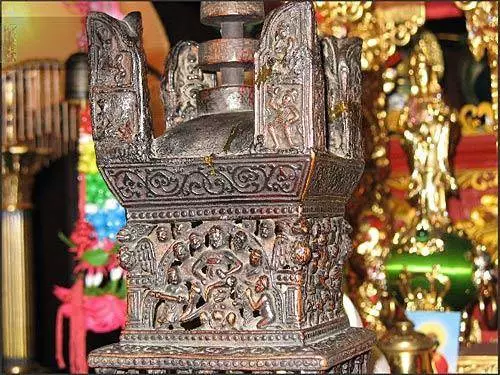Ningbo is a port city that is at a distance of sixty kilometers from Shanghai, in the center of the industrial area in the south-eastern part of Zhejiang. The name of the city means "calm water" - which is not surprising, because thanks to this property of coastal waves Ningbo turned into one of the tops - dozens of ports on the planet. Nowadays, he is at the seventh place among container ports. Over the past decades, the city experienced a very intensive increase in population population, now there is about six million people here. Ningbo is located in the center of the state coastline south from the Delta of the Yangtze River and occupies an area of 9365 square meters, of which 1033 sq. Km is the central part of the city.
Ningbo was the port city of high value from the period of the Sun dynasty. After the end of the opium war, he became one of the best ports in Middle Kingdom due to his favorable position. In our Ningbo, except that quite well developed in economic terms, is one of the most beautiful cities - because of the excellent natural landscapes. Thanks to the seaside location in the field of subtropical monsoon climate, moderate humidity is maintained and a sufficiently high temperature is a minimum of sixteen degrees Celsius. The city is attractive for visiting at any time of the year. For example, in the summer you can visit the area Tianhe , in the area of the mountains Tiantai, Sueudou , in the vicinity of the city Sikou , and in winter - go to Hot Sources Nanxies . North Ningbo is rich in amazing lakes - such as West Lake, Lake Thai and Dunqian - To look at them. Tourists come to all seasons of the year. Ningbo is, of course, a modern city that lives according to new trends, but its inhabitants still do not forget traditional handicrafts - weave vases from bamboo, make souvenirs in the form of animal figures, mats, carvings on bamboo - make sculptures from it.
Ningbo is also one of the most ancient cities in the Middle Kingdom, which has repeatedly happened to experience both the lifts and the decline of the rules of the dynasties. The city is considered the place of origin of the archaeological culture of Neolith Hamoud, which is seven thousand years. At a distance of twenty-two kilometers from Ningbo was founded Museum of Culture Hamuda which was especially famous for skillfully made ceramic products. Very ancient cultures that flourished in this area have influenced the fact that in our days Ningbo is exactly what we see him - a city, developed economically and having a very rich historical and cultural heritage.

Ningbo, among other things, this is one of the first cities in the Middle Kingdom, which were open to the Western world, and therefore, the missionaries began to come very early in the local seats. As a result - in Ningbo, in comparison with all other cities in the state, quite strong positions of the Christian faith. On the other hand, the close location of the Putoshan's sacred island and the presence of a large number of famous Buddhist temples strengthens the meaning of Buddhism. The city has 565 Buddhist shrines, 298 - Christian, among which 52 are Catholic. There is also one mosque.
Is also of interest Library tianyi. . Her age - four hundred thirty years. This institution is the most ancient private library in Middle Kingdom. It is close to the lunar lake.
Bridge of the guy construction who stretches over the bay of Hangzhouvan, is the longest sea bridge on the planet - its length is thirty-six kilometers.

Temples in Ningbo
A very developed Buddhist culture is visible here thanks to a large number of impressive historical temples. Temple Ashoka (Ayuvan), which is a thousand seven hundred years old, keeps very rare relics Buddhism of Shakyamuni. Teanteun Temple It is impressive thanks to unreal landscapes and sophisticated architectural style. Temple Boy - One of the oldest wooden buildings built in the Ming Epoch is known for the fact that its walls are a huge statue of the sitting porcelain Buddha - its age is six centuries. In the temple there is also a sememeter bronze tower - there are several thousand pictures of Buddha and ancient sutra in it. The construction of the church of Boy began in 1573, but his pace was low, and the work was completed only in the 1620th. In the eighteenth century, restoration work was carried out in the temple, after them his appearance did not change to this day. The church of Boy is recognized as the most striking example of the local architecture. Other attractions in Ningbo are Buddhist shrines - Temple Quote and Pagoda Tianfeng and Xiantun.
Temple Ayuvan Located near the peak of Lukhua in the Taiya Mountains, one of the most important for adherents of Buddhist faith in China. The temple refers to the school of Chan - Buddhism (Zen - Buddhism), a large number of believers from China seek to get into it, many of them come from Japan, also a large number from the countries of Europe and America - they will come here at any time of the year. The Temple of Ashoka Great is the only temple in the state, which was named by the name of Indian Lord. He became famous for the patronage and spread of Buddhism. According to historical information, Ashoka saw Ningbo as a place where peace and harmony reigns. Many legends are related to the erection and early history of the temple complex.
It is likely that the original temple was built during the rule of the Western Zhou dynasty - in 282nd BC. After this date, the information about the life of the temple is lost for a long time. The most important relics of the Temple of Ashoka Great is the parietal bone of the Buddha Shakyamuni. It is believed that this is one of eighty-four thousand (!) Crowds built by the ruler of Ashokok, where the power is stored. This relic is located in a stone stage with the seven steps located in the hall of the Stupa.

One of the pagodas in the temple is known thanks to the Buddha Collection. And in 1993 - m during restoration work, there were calligraphy, which belongs to the epochs of Yuan, Min and Qing. In addition, there is an original calligraphic collection in Ayivan, in which the work of the emperor Qianpun, which rules in 1736 - 1795, during the Qing dynasty - he left them during the visit to the temple.
